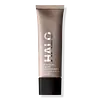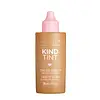Smashbox Halo Healthy Glow Tinted Moisturizer Broad Spectrum SPF 25 Versus Pacifica Kind Tint Tinted Serum
What's inside
What's inside
 Key Ingredients
Key Ingredients

 Benefits
Benefits

 Concerns
Concerns

 Ingredients Side-by-side
Ingredients Side-by-side

Ethylhexyl Methoxycinnamate 6.7%
UV AbsorberTitanium Dioxide 3.1%
Cosmetic ColorantZinc Oxide 1.3%
Cosmetic ColorantWater
Skin ConditioningOctyldodecyl Neopentanoate
EmollientButyloctyl Salicylate
Skin ConditioningDimethicone
EmollientButylene Glycol
HumectantMethyl Trimethicone
Skin ConditioningNiacinamide
SmoothingCetyl PEG/PPG-10/1 Dimethicone
EmulsifyingLauryl PEG-9 Polydimethylsiloxyethyl Dimethicone
Skin ConditioningDiethylhexyl Succinate
EmollientLaureth-4
EmulsifyingTocopheryl Acetate
AntioxidantSodium Hyaluronate
HumectantLecithin
EmollientRosa Hybrid Flower Extract
Skin ConditioningPyrus Malus Fruit Extract
Skin ConditioningLens Esculenta Fruit Extract
Skin ConditioningCitrullus Lanatus Fruit Extract
Skin ConditioningLycium Chinense Fruit Extract
AntioxidantPalmitoyl Hexapeptide-14
Skin ConditioningPeat Extract
Skin ConditioningGold
Cosmetic ColorantSodium Lactate
BufferingMethicone
EmollientSodium PCA
HumectantHydrolyzed Wheat Protein/Pvp Crosspolymer
Glycerin
HumectantCI 77120
Cosmetic ColorantMagnesium Sulfate
Dimethyl Isosorbide
SolventMaltodextrin
AbsorbentTriethoxycaprylylsilane
Dimethicone Crosspolymer-3
Skin ConditioningSilica
AbrasiveAluminum Hydroxide
EmollientDimethicone/PEG-10/15 Crosspolymer
Trimethylsiloxysilicate
EmollientHexylene Glycol
EmulsifyingIsostearic Acid
CleansingCaprylyl Glycol
EmollientStearic Acid
CleansingPolyglyceryl-2 Triisostearate
EmulsifyingDipentaerythrityl Tri-Polyhydroxystearate
EmollientDipropylene Glycol
HumectantSodium Citrate
BufferingBHT
AntioxidantDisodium EDTA
Sodium Benzoate
MaskingPotassium Sorbate
PreservativePhenoxyethanol
PreservativeMica
Cosmetic ColorantCI 77891
Cosmetic ColorantCI 77491
Cosmetic ColorantCI 77492
Cosmetic ColorantCI 77499
Cosmetic ColorantCI 77163
Cosmetic ColorantEthylhexyl Methoxycinnamate 6.7%, Titanium Dioxide 3.1%, Zinc Oxide 1.3%, Water, Octyldodecyl Neopentanoate, Butyloctyl Salicylate, Dimethicone, Butylene Glycol, Methyl Trimethicone, Niacinamide, Cetyl PEG/PPG-10/1 Dimethicone, Lauryl PEG-9 Polydimethylsiloxyethyl Dimethicone, Diethylhexyl Succinate, Laureth-4, Tocopheryl Acetate, Sodium Hyaluronate, Lecithin, Rosa Hybrid Flower Extract, Pyrus Malus Fruit Extract, Lens Esculenta Fruit Extract, Citrullus Lanatus Fruit Extract, Lycium Chinense Fruit Extract, Palmitoyl Hexapeptide-14, Peat Extract, Gold, Sodium Lactate, Methicone, Sodium PCA, Hydrolyzed Wheat Protein/Pvp Crosspolymer, Glycerin, CI 77120, Magnesium Sulfate, Dimethyl Isosorbide, Maltodextrin, Triethoxycaprylylsilane, Dimethicone Crosspolymer-3, Silica, Aluminum Hydroxide, Dimethicone/PEG-10/15 Crosspolymer, Trimethylsiloxysilicate, Hexylene Glycol, Isostearic Acid, Caprylyl Glycol, Stearic Acid, Polyglyceryl-2 Triisostearate, Dipentaerythrityl Tri-Polyhydroxystearate, Dipropylene Glycol, Sodium Citrate, BHT, Disodium EDTA, Sodium Benzoate, Potassium Sorbate, Phenoxyethanol, Mica, CI 77891, CI 77491, CI 77492, CI 77499, CI 77163
Water
Skin ConditioningSqualane
EmollientCaprylic/Capric Triglyceride
MaskingStearyl Alcohol
EmollientCetyl Alcohol
EmollientHelianthus Annuus Seed Oil
EmollientCoco-Caprylate
EmollientGlyceryl Stearate
EmollientButyrospermum Parkii Butter
Skin ConditioningSodium Hyaluronate
HumectantSr-Hydrozoan Polypeptide-1
HumectantAscorbic Acid
AntioxidantCitrus Aurantium Dulcis Flower Extract
Skin ConditioningNiacinamide
SmoothingTocopherol
AntioxidantCaffeine
Skin ConditioningJasminum Officinale Flower Extract
MaskingLeuconostoc/Radish Root Ferment Filtrate
AntimicrobialXanthan Gum
EmulsifyingSodium Phytate
Lauroyl Lysine
Skin ConditioningGlycerin
HumectantCitric Acid
BufferingPropanediol
SolventPhenoxyethanol
PreservativeEthylhexylglycerin
Skin ConditioningSodium Benzoate
MaskingCI 77891
Cosmetic ColorantIron Oxides
Water, Squalane, Caprylic/Capric Triglyceride, Stearyl Alcohol, Cetyl Alcohol, Helianthus Annuus Seed Oil, Coco-Caprylate, Glyceryl Stearate, Butyrospermum Parkii Butter, Sodium Hyaluronate, Sr-Hydrozoan Polypeptide-1, Ascorbic Acid, Citrus Aurantium Dulcis Flower Extract, Niacinamide, Tocopherol, Caffeine, Jasminum Officinale Flower Extract, Leuconostoc/Radish Root Ferment Filtrate, Xanthan Gum, Sodium Phytate, Lauroyl Lysine, Glycerin, Citric Acid, Propanediol, Phenoxyethanol, Ethylhexylglycerin, Sodium Benzoate, CI 77891, Iron Oxides
Ingredients Explained
These ingredients are found in both products.
Ingredients higher up in an ingredient list are typically present in a larger amount.
Ci 77891 is a white pigment from Titanium dioxide. It is naturally found in minerals such as rutile and ilmenite.
It's main function is to add a white color to cosmetics. It can also be mixed with other colors to create different shades.
Ci 77891 is commonly found in sunscreens due to its ability to block UV rays.
Learn more about CI 77891Glycerin is already naturally found in your skin. It helps moisturize and protect your skin.
A study from 2016 found glycerin to be more effective as a humectant than AHAs and hyaluronic acid.
As a humectant, it helps the skin stay hydrated by pulling moisture to your skin. The low molecular weight of glycerin allows it to pull moisture into the deeper layers of your skin.
Hydrated skin improves your skin barrier; Your skin barrier helps protect against irritants and bacteria.
Glycerin has also been found to have antimicrobial and antiviral properties. Due to these properties, glycerin is often used in wound and burn treatments.
In cosmetics, glycerin is usually derived from plants such as soybean or palm. However, it can also be sourced from animals, such as tallow or animal fat.
This ingredient is organic, colorless, odorless, and non-toxic.
Glycerin is the name for this ingredient in American English. British English uses Glycerol/Glycerine.
Learn more about GlycerinNiacinamide is a multitasking form of vitamin B3 that strengthens the skin barrier, reduces pores and dark spots, regulates oil, and improves signs of aging.
And the best part? It's gentle and well-tolerated by most skin types, including sensitive and reactive skin.
You might have heard of "niacin flush", or the reddening of skin that causes itchiness. Niacinamide has not been found to cause this.
In very rare cases, some individuals may not be able to tolerate niacinamide at all or experience an allergic reaction to it.
If you are experiencing flaking, irritation, and dryness with this ingredient, be sure to double check all your products as this ingredient can be found in all categories of skincare.
When incorporating niacinamide into your routine, look out for concentration amounts. Typically, 5% niacinamide provides benefits such as fading dark spots. However, if you have sensitive skin, it is better to begin with a smaller concentration.
When you apply niacinamide to your skin, your body converts it into nicotinamide adenine dinucleotide (NAD). NAD is an essential coenzyme that is already found in your cells as "fuel" and powers countless biological processes.
In your skin, NAD helps repair cell damage, produce new healthy cells, support collagen production, strengthen the skin barrier, and fight environmental stressors (like UV and pollution).
Our natural NAD levels start to decline with age, leading to slower skin repair, visible aging, and a weaker skin barrier. By providing your skin niacinamide, you're recharging your skin's NAD levels. This leads to stronger, healthier, and younger looking skin.
Another name for vitamin B3 is nicotinamide. This vitamin is water-soluble and our bodies don't store it. We obtain Vitamin B3 from either food or skincare. Meat, fish, wheat, yeast, and leafy greens contain vitamin B3.
The type of niacinamide used in skincare is synthetically created.
Learn more about NiacinamidePhenoxyethanol is a preservative that has germicide, antimicrobial, and aromatic properties. Studies show that phenoxyethanol can prevent microbial growth. By itself, it has a scent that is similar to that of a rose.
It's often used in formulations along with Caprylyl Glycol to preserve the shelf life of products.
Sodium Benzoate is a preservative. It's used in both cosmetic and food products to inhibit the growth of mold and bacteria. It is typically produced synthetically.
Both the US FDA and EU Health Committee have approved the use of sodium benzoate. In the US, levels of 0.1% (of the total product) are allowed.
Sodium benzoate works as a preservative by inhibiting the growth of bacteria inside of cells. It prevents the cell from fermenting a type of sugar using an enzyme called phosphofructokinase.
It is the salt of benzoic acid. Foods containing sodium benzoate include soda, salad dressings, condiments, fruit juices, wines, and snack foods.
Studies for using ascorbic acid and sodium benzoate in cosmetics are lacking, especially in skincare routines with multiple steps.
We always recommend speaking with a professional, such as a dermatologist, if you have any concerns.
Learn more about Sodium BenzoateSodium Hyaluronate is hyaluronic acid's salt form. It is commonly derived from the sodium salt of hyaluronic acid.
Like hyaluronic acid, it is great at holding water and acts as a humectant. This makes it a great skin hydrating ingredient.
Sodium Hyaluronate is naturally occurring in our bodies and is mostly found in eye fluid and joints.
These are some other common types of Hyaluronic Acid:
Learn more about Sodium HyaluronateWater. It's the most common cosmetic ingredient of all. You'll usually see it at the top of ingredient lists, meaning that it makes up the largest part of the product.
So why is it so popular? Water most often acts as a solvent - this means that it helps dissolve other ingredients into the formulation.
You'll also recognize water as that liquid we all need to stay alive. If you see this, drink a glass of water. Stay hydrated!
Learn more about Water